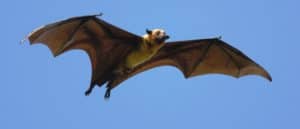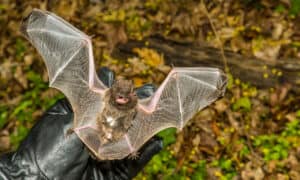Many people think bats are just pests, “flying rodents,” or even something to be scared of. You can probably thank Dracula for that one… But there is so much more to these unique little flying mammals – bats are actually super cool! In fact, bats are extremely beneficial to humans. Did you know that we wouldn’t have avocados, mangoes, or bananas without bats? Or that there are at least 1,400 different species of bats in the world? Let’s check out some more amazing things about bats with 10 incredible bat facts!
1. There Are Bats in Almost Every Corner of the World
Bats live on every single continent on earth except for Antarctica. There are bats as far north as the Arctic Circle, and as far south as Argentina and the southernmost tip of South Africa. The largest bat is the giant golden-crowned flying fox (Acerodon jubatus), a rare type of fruit bat that only lives in the Philippines. Not only can this bat weigh up to three and a half pounds, but it has a five to six-foot-long wingspan!
The smallest bat in the world is the Kitti’s hog-nosed bat, a near-threatened bat species that lives in southeast Myanmar and western Thailand. This tiny bat is quite likely the smallest mammal on earth. It only weighs one sixteenth to three thirty-seconds of an ounce. That is less than a U.S. penny! Its body is only one and one eighth to one and three eighths inches long, and it has a tiny wingspan of only six inches.
2. Bats Are the Only Mammal in the World that Can Fly
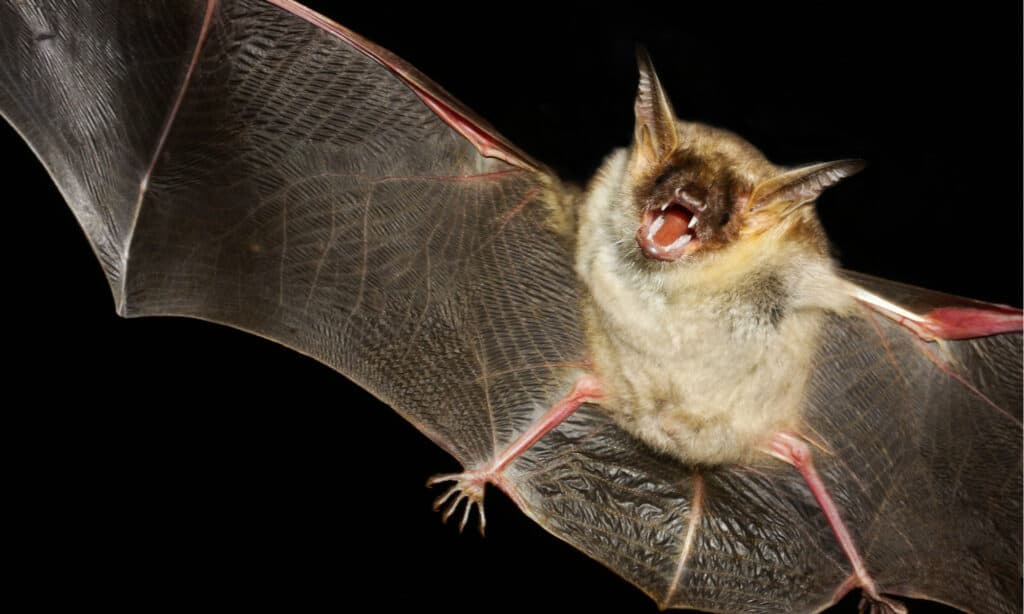
Bats are the only mammals that are capable of true flight.
©iStock.com/Geza Farkas
Although a flying squirrel appears to fly, in truth it is only gliding. Bats, on the other hand, are the only mammals in the world that can actually fly and control their flight. Their scientific name, Chiroptera, originates from the Greek language, and means “hand wing”. Bat wings are composed of elongated finger bones that are covered with thin layers of skin.
While birds flap their entire forearm limbs to fly, bats only flap these membrane-covered digits. That would be like if you tried to fly by only flapping your hands and not moving your arms at all! In addition to flight, bats’ wings help them to regulate their body temperature and blood pressure.
3. Bats Sleep While Hanging Upside Down
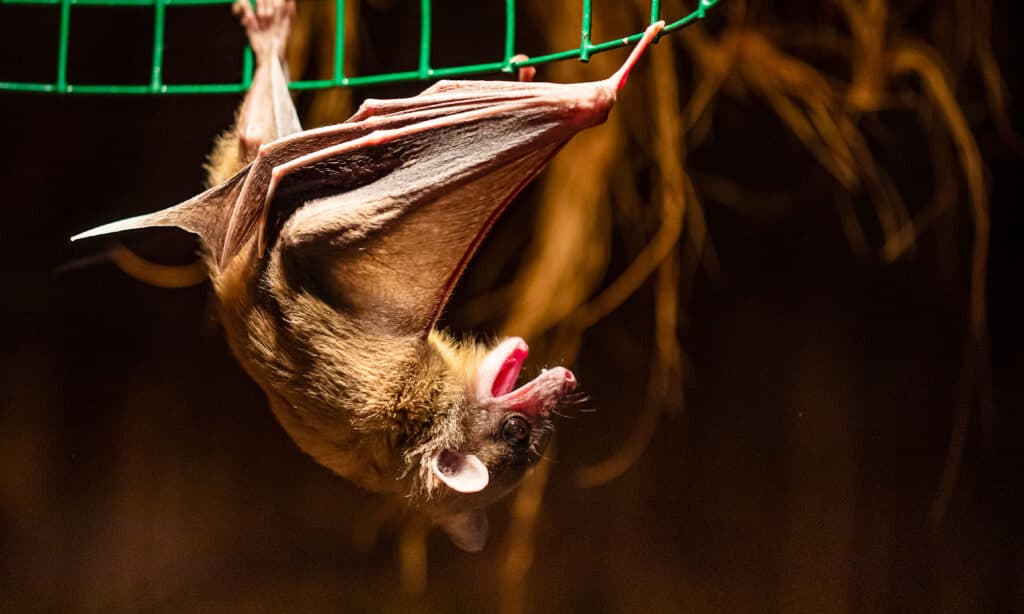
Hanging upside down helps bats to gain the momentum needed for flight.
©Here/Shutterstock.com
One of the most iconic images of bats is to see these intriguing animals hanging upside down while snuggling inside the warmth of their wings. But why do bats hang upside down, and how do they do it?
Scientists think that hanging upside down is actually quite advantageous for bats since it helps them to take off much more quickly when flying. While birds have hollow bones to help with flight, bats are mammals and have heavy, solid bones. This extra weight requires them to gain much more momentum to take flight. By hanging upside down, bats can just fall and start flying. This gives them that additionally needed momentum as they take off for flight.
But since bats are mammals, wouldn’t hanging upside down give them a massive headrush? Nope! Here’s an especially incredible bat fact: bats have specialized valves in both their veins and their arteries that keep the blood in their bodies flowing in the proper direction. This keeps the blood from rushing to their heads, even when they’re hanging upside down!
4. Some Bats Hibernate
Contrary to popular belief, not all types of bats hibernate. Many spotted bats (Euderma maculatum), for example, migrate to warmer regions when it gets cold rather than hibernating. However, there are many other bats that spend the winter hibernating in caves or mines, like northern long-eared bats (Myotis septentrionalis).
During hibernation, the body systems of hibernating bats slow down tremendously. For example, during the summer the mouse-eared bat (Myotis myotis) normally has a heart rate of around 600 beats per minute (that’s about 10 beats per second), but during hibernation, its heartbeat can decrease to as low as only 18 to 80 beats per minute!
5. Vampire Bats Aren’t as Scary as You May Think
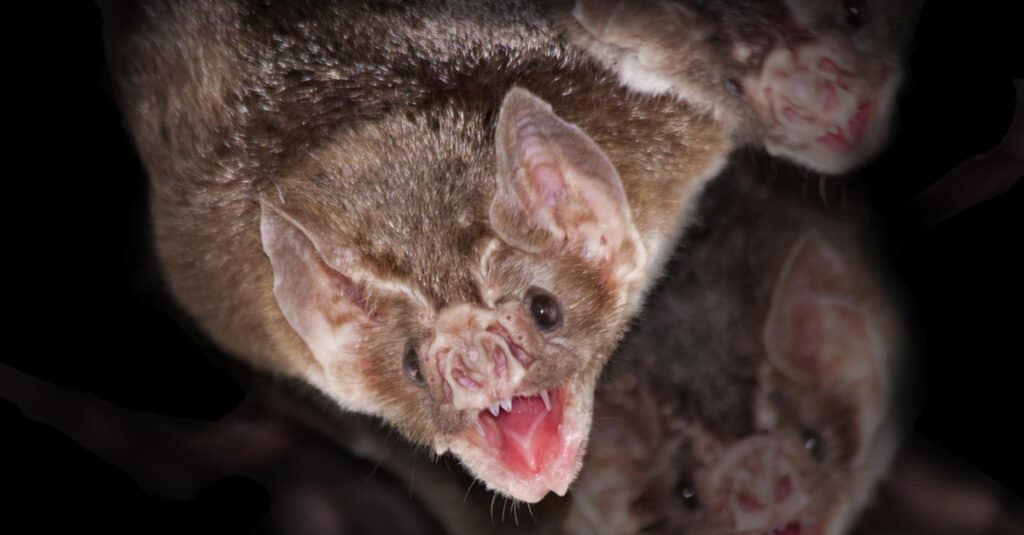
Despite living on blood, vampire bats do not attack humans
©belizar/Shutterstock.com
Although the story of Dracula originated in eastern Europe, real vampire bats only live in South and Central America, and they do not transform into a human form either. However, vampire bats do drink blood – or more accurately, they lap up blood with their tongues. There are three types of vampire bats: the common vampire bat (Desmodus rotundus), the white-winged vampire bat (Diaemus youngi), and the hairy-legged vampire bat (Diphylla ecaudata).
Vampire bats are the only mammals that live off of blood. Don’t worry though, vampire bats do not actively attack humans! They typically seek blood from livestock like cattle, horses, and sometimes chickens. They are not violent animals, and the blood that they take from a host is not enough to kill the animal. Using tiny razor-sharp teeth, vampire bats pierce their blood donor’s skin and then lap up the blood as it spills out. The bats’ saliva contains anticoagulants that prevent blood clotting, making it easier to lap up. Scientists have used saliva from vampire bats to develop treatments for human victims of ischemic strokes and heart issues.
6. Bats Are Vital to Some of Our Favorite Foods
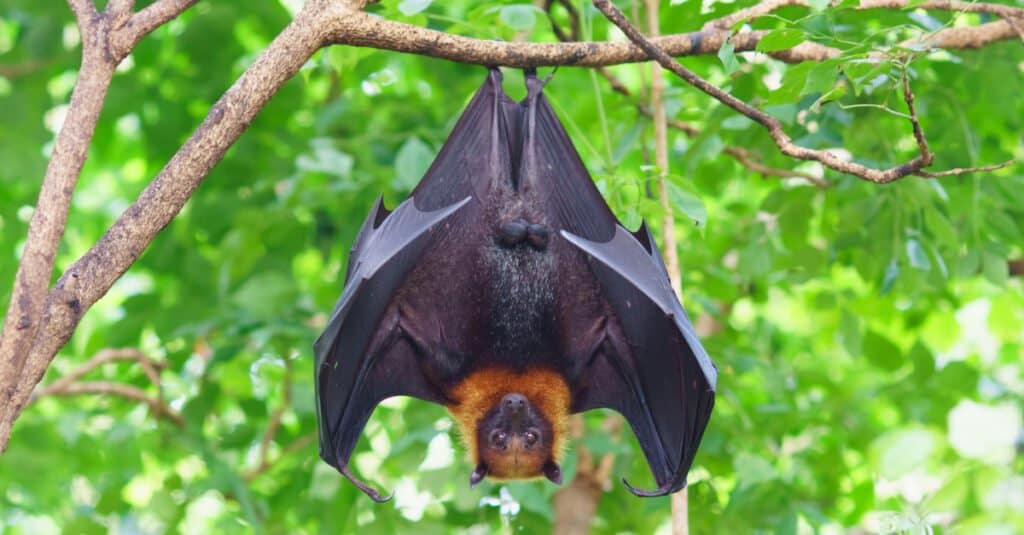
Many bats eat fruit and they are natural pollinators, helping to spread nuts and seeds
©jekjob/Shutterstock.com
Vampire bats are the only type of bats that eat blood. Remember, there are at least 1,400 bat species across the globe, and each has its own unique diet. Some bats eat fruit, pollen from flowers, and seeds, and some even drink nectar like hummingbirds! These bats are natural pollinators that help to spread seeds for fruit, cacao, and nuts. At least 300 different fruit species depend on bats for pollination! In other words, without bats, we wouldn’t be able to enjoy things like figs, bananas, mangoes, avocadoes, or agave. In addition, nearly 80 different human medicines are derived from plants that rely on bats for survival.
The fishing-eating bat (Myotis vivesi) and the fisherman or bulldog bat (Noctilio leporinus), on the other hand, mainly eat fish. The fringe-lipped bat or frog-eating bat (Trachops cirrhosus) likes to feast on frogs. It can tell the difference between poisonous frogs and edible frogs just by listening to the call of male frogs! Many other bat species exclusively eat insects. Insect-eating bats are especially helpful to farmers since these bats can take down hordes of insects numbering in the thousands every single night!
7. Bats Live in Colonies and Reproduce Slowly
There are a few select bat species that live more solitary lives, like the Hardwicke’s woolly bat. This unusual animal is a bit of a rebel in the bat world, and actually roosts inside carnivorous tropical pitcher plants! However, most bats live in large groups called colonies. Colonies can contain as few as 100 bats, or they can be quite large with thousands or even millions of bats! Bats roost together in colonies in sheltered areas like caves, mines, trees, and barns. Some colonies may contain both male and female bats, but most are gender-specific, with females living together to care for their young.
Female bats are pregnant for an unusually long time compared to other mammals their size. Some species are pregnant for six to nine weeks, while others may be pregnant for several months. In the spring, female bats gather together in maternity roosts and nursery colonies to give birth and raise their young. In general female bats only give birth to one baby, or “pup” each year (with the exception of the easter red bat (Lasiurus borealis), which gives birth to one to five pups at a time). Mother bats keep their baby pups close and feed them breastmilk until they are old enough to fly and venture out to find food on their own.
8. The Largest Bat Colony in the World is in Texas

Most bats live in large colonies. The largest colony is in Texas and is home to more than 15 million bats!
©Janelle Lugge/Shutterstock.com
Bracken Cave, located near San Antonio, Texas, is home to the largest bat colony on earth. Over 15 million Mexican free-tailed bats (Tadarida brasiliensis) live there! Bracken Cave functions as an incredibly important maternity roost for female Mexican free-tailed bats who gather there each year to give birth and care for their young pups. These bats provide excellent pest-control services while utilizing the cave, as they eat many crop pests in the area. In a single summer night, this colony gobbles up at least 100 tons of corn earworm moths!
Unfortunately, much of the land surrounding Bracken Cave has been developed and fragmented, but in the 1990s Bat Conservation International purchased much of the area (including the cave). Today they are working to restore the biodiversity, and they care for and protect the cave and its millions of batty inhabitants.
9. Bats Are Some of the Fastest Mammals on Earth

Bats can reach the incredible speed of 100 miles per hour!
©Rudmer Zwerver/Shutterstock.com
Speaking of the Mexican free-tailed bat, did you know that this little flying furball is ridiculously fast? Here’s a rather recently discovered bat fact: it is one of the fastest mammals on earth! Mexican free-tailed bats can fly extremely fast in short bursts of speed, going as fast as 100 miles per hour! And that’s not diving through the air, that’s using just their wing power while flying parallel to the ground. To give you an idea of just how fast that is, a cheetah can sprint up to 75 miles per hour.
10. Bats Are Not Blind
Yes, bats fly around in the dark and are famous for their superb echolocation skills. But believe it or not, bats are not blind! In fact, most bat species have excellent eyesight. Large flying foxes (Pteropus vampyrus), for example, have great night vision, while Pallas’s long-tongued bat (Glossophaga soricine) can see ultraviolet light. Even bats that do not have the best vision still depend on visual cues when they are navigating long distances and tracking.
However, bats do utilize several different senses, in addition to vision. The most well-known batty super-sense is of course echolocation. Bats make high-pitched sounds and use their sensitive ears to detect when the soundwaves reflect back off of objects. In addition, many bats use their sense of smell to track down food or to communicate. Female free-tailed bats, for example, can identify their pup by its individually unique smell, even in a colony of thousands of others. Studies have also shown that Jamaican bats (Artibeus jamaicensis) use their sense of smell to track down and identify food items as well.
Up Next:
- The Top 10 Largest Bats in the World
- Cutest Bat: Which Bat Species is The Cutest in The World?
- 10 Incredible Fruit Bat Facts
- 10 Incredible Vampire Bat Facts
The photo featured at the top of this post is © iStock.com/Geza Farkas
Sources
- , Available here: https://www.batcon.org/about-bats/faq/
- , Available here: https://animals.sandiegozoo.org/animals/bat
- , Available here: https://www.nps.gov/subjects/bats/index.htm
- , Available here: https://www.bats.org.uk/about-bats/where-do-bats-live/bat-roosts/maternity-roosts#:~:text=Bats%20usually%20give%20birth%20to,roost%20to%20forage%20for%20food.
- , Available here: https://www.nps.gov/subjects/bats/hibernate-or-migrate.htm
- , Available here: https://www.ahajournals.org/doi/full/10.1161/01.STR.0000166050.84056.48
- , Available here: https://www.newscientist.com/article/mg22530090-100-tiny-bat-makes-home-in-a-carnivorous-plant/
- , Available here: https://pubmed.ncbi.nlm.nih.gov/14534585/#:~:text=Bats%20orient%20primarily%20by%20echolocation,a%20wavelength%20of%20310%20nm.
- , Available here: https://journals.biologists.com/jeb/article/225/3/JEB243479/274192/Jamaican-bats-can-smell-food-and-drive-themselves
- , Available here: https://journals.biologists.com/jeb/article/64/2/489/22278/Some-Advanced-Flight-Manoeuvres-of-Bats
Thank you for reading! Have some feedback for us? Contact the AZ Animals editorial team.



